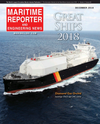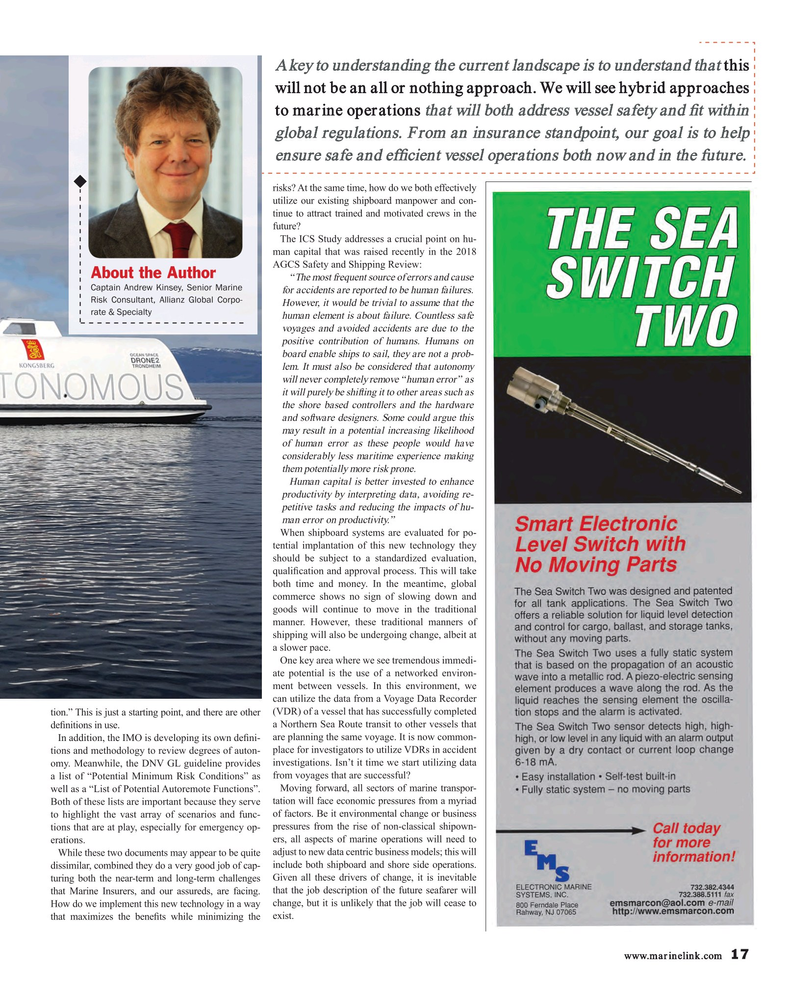
Page 17: of Maritime Reporter Magazine (December 2018)
Great Ships of 2018
Read this page in Pdf, Flash or Html5 edition of December 2018 Maritime Reporter Magazine
A key to understanding the current landscape is to understand that this will not be an all or nothing approach. We will see hybrid approaches to marine operations that will both address vessel safety and ? t within global regulations. From an insurance standpoint, our goal is to help ensure safe and ef? cient vessel operations both now and in the future. risks? At the same time, how do we both effectively utilize our existing shipboard manpower and con- tinue to attract trained and motivated crews in the future?
The ICS Study addresses a crucial point on hu- man capital that was raised recently in the 2018
AGCS Safety and Shipping Review:
About the Author “The most frequent source of errors and cause
Captain Andrew Kinsey, Senior Marine for accidents are reported to be human failures.
Risk Consultant, Allianz Global Corpo-
However, it would be trivial to assume that the rate & Specialty human element is about failure. Countless safe voyages and avoided accidents are due to the positive contribution of humans. Humans on board enable ships to sail, they are not a prob- lem. It must also be considered that autonomy will never completely remove “human error” as it will purely be shifting it to other areas such as the shore based controllers and the hardware and software designers. Some could argue this may result in a potential increasing likelihood of human error as these people would have considerably less maritime experience making them potentially more risk prone.
Human capital is better invested to enhance productivity by interpreting data, avoiding re- petitive tasks and reducing the impacts of hu- man error on productivity.”
When shipboard systems are evaluated for po- tential implantation of this new technology they should be subject to a standardized evaluation, quali? cation and approval process. This will take both time and money. In the meantime, global commerce shows no sign of slowing down and goods will continue to move in the traditional manner. However, these traditional manners of shipping will also be undergoing change, albeit at a slower pace.
One key area where we see tremendous immedi- ate potential is the use of a networked environ- ment between vessels. In this environment, we can utilize the data from a Voyage Data Recorder tion.” This is just a starting point, and there are other (VDR) of a vessel that has successfully completed de? nitions in use. a Northern Sea Route transit to other vessels that
In addition, the IMO is developing its own de? ni- are planning the same voyage. It is now common- tions and methodology to review degrees of auton- place for investigators to utilize VDRs in accident omy. Meanwhile, the DNV GL guideline provides investigations. Isn’t it time we start utilizing data a list of “Potential Minimum Risk Conditions” as from voyages that are successful? well as a “List of Potential Autoremote Functions”. Moving forward, all sectors of marine transpor-
Both of these lists are important because they serve tation will face economic pressures from a myriad to highlight the vast array of scenarios and func- of factors. Be it environmental change or business tions that are at play, especially for emergency op- pressures from the rise of non-classical shipown- erations. ers, all aspects of marine operations will need to
While these two documents may appear to be quite adjust to new data centric business models; this will dissimilar, combined they do a very good job of cap- include both shipboard and shore side operations. turing both the near-term and long-term challenges Given all these drivers of change, it is inevitable that Marine Insurers, and our assureds, are facing. that the job description of the future seafarer will
How do we implement this new technology in a way change, but it is unlikely that the job will cease to that maximizes the bene? ts while minimizing the exist. www.marinelink.com 17
MR #12 (10-17).indd 17 MR #12 (10-17).indd 17 12/7/2018 11:15:49 AM12/7/2018 11:15:49 AM

 16
16

 18
18
